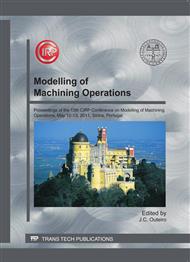p.525
p.535
p.545
p.554
p.564
p.573
p.579
p.591
p.600
An XPS Study of the Stratified Built-up Layers Developed onto the Tool Surface in the Dry Drilling of Ti Alloys
Abstract:
Secondary tool adhesion wear is commonly provoked by two effects, whose nature depends on the placement of the adhered material. The so-called Built-Up Layer (BUL) is formed on the tool rake face and the Built-Up Edge (BUE) is developed on the cutting tool edge. These effects can be developed by different causes depending on both the cutting conditions and the material to be machined. In this work, X-Ray Photoelectron Spectroscopy (XPS) has been used to analyze the built-up layers formed during the dry drilling processes of aeronautical Ti-6Al-4V alloy. Changes in the Ti oxidation state in each layer have allowed proposing a BUL formation mechanism based on chemical reactions of the workpiece material during the drilling process. Effects of these reactions have been contrasted through the XPS analysis of the chip generated in the process. In parallel, SEM and EDS have been used as complementary techniques for obtaining further information about the BUL nature.
Info:
Periodical:
Pages:
564-572
Citation:
Online since:
April 2011
Keywords:
Price:
Сopyright:
© 2011 Trans Tech Publications Ltd. All Rights Reserved
Share:
Citation:


